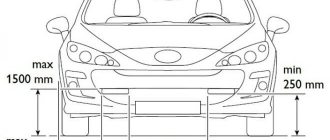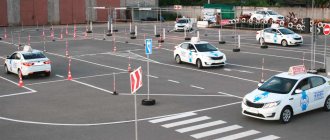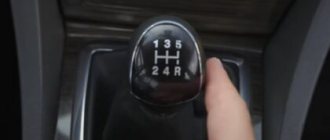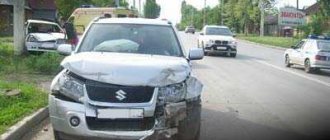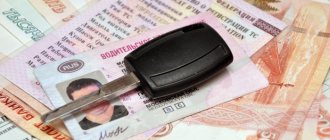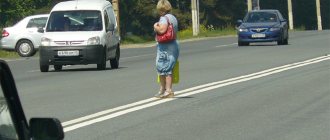The movement of a car is subject not only to certain laws, but also, above all, to the will of the driver. Strictly speaking, the laws of car motion come into force only after one or another, correct or incorrect, action of the driver. The driver and designer must take into account and correctly apply the laws of vehicle motion.
What do you need to understand to start driving a car from scratch?
How to learn to drive a car if you have never driven a car or had initial experience of riding a scooter or moped? Many people really start to think about this issue without having proper driving experience. Others want to switch to more reliable transport from a scooter or motorcycle, and already have an idea about driving a vehicle. Since driving a car is a responsible business, and dangerous enough that you don’t feel a sense of fear before your first trip, you should thoroughly prepare for it.
First you need to master the theoretical part, and specifically learn the traffic rules. This will not only help you pass exams and be certified by the traffic police, but will also ensure safety on the road. In this case, illustrated textbooks and manuals can be useful, which contain not only the rules of driving on the roads, but also show all the signs and road markings. There are many video driving lessons on the Internet that will show you how to act in a given situation. But you need to watch them in advance, since in the event of an emergency, no video will help. To prepare for the theory, you can use ready-made tickets that are freely available. All this will certainly help the future driver prepare for driving from scratch.
Of course, theory alone will not be enough to become a first-class driver and then feel confident on the road. The driver must not only steer and press the pedals, but also monitor other road users, understand their actions and soberly assess the situation. In other words, you need to know how to react at one time or another and be able to switch to emergency mode in time to avoid an accident. The necessary skills come with practice, and with every trip on the highway will come experience. But you will have to get it after driving school and obtaining a license from the traffic police.
What are the features of driving a car with a manual transmission?
The skills of correct gear shifting when using a car with an automatic transmission must be developed to the point of automaticity. They will be helped by professional manual driving lessons for beginners.
In cars with a manual transmission, there are no complex electronics that equalize the speed of rotation of the gears on the shaft, but there is a clutch pedal. It disengages the transmission so that the driver can place the gear lever in the desired position and change the speed.
Most cars have 4-5 speeds and reverse gear. Let's look at why they are needed.
- "Neutral". This is the switch position at which no torque is transmitted to the wheels. In this position, the car cannot start moving, even if you press the gas pedal.
- First. It is designed to allow the car to move. At this speed you can accelerate to 20 km per hour. It is turned on when cornering, climbing a steep mountain, or when performing maneuvers in a small space. Fuel consumption at this speed is maximum.
- The second is transitional. It is turned on when going down a hill or maneuvering in traffic jams. It is also transitional to other high-speed gears.
- Third, fourth and fifth gears allow you to accelerate the car to the desired speed on the road.
- Rear - necessary for turns and parking. You need to turn it on carefully, because a car with reverse engaged accelerates faster than in first gear.
How can you quickly learn traffic rules?
Even if you memorize the traffic rules with all the points, in practice it is difficult to navigate and apply the necessary rule. In order not to “fall into a stupor” at a crucial moment, you need to not just memorize the text, as in school, but try to understand and understand the essence of what was written, to imagine the situation in real life.
It is easy to remember the rules of the road, and then successfully apply them in practice, in a very simple way - drive more often next to an experienced driver. Moreover, you need to not only monitor his actions, but analyze what he sees and try to compare it with the rules. If something suddenly becomes unclear, you need to try to remember the situation and model it in front of the instructor in order to receive detailed explanations from a specialist. In addition, do not be shy to ask questions to taxi drivers or familiar drivers who can share their experience and give tips. No less important is the choice of printed manuals, which should contain illustrations and diagrams of certain situations on the road. Visualization will help you better remember information and enhance perception.
Basic principles that will help you learn traffic rules faster if you follow them:
- Learn a few points from the rules every day, instead of reading all the material in one day.
- Review the material covered at the end of the week. This will help you quickly memorize the rules of DD.
- Take a break from studying tickets every 40 minutes to avoid overwork. In addition, it will help you go through several points in a meaningful way and improve your perception.
- Pay special attention to signs and road markings.
In addition to these rules, special computer test programs with questions about traffic rules will also help in studying traffic rules. But when choosing such a service, you need to give preference to the latest version, since the information is constantly updated and supplemented.
How can novice men, girls and women not be afraid to drive?
Of course, not everyone can just get behind the wheel and hit the road the first time. Some novice drivers are nervous before a trip, while others are afraid. Often, fears overtake girls and women, and this interferes with their learning. While driving you need to be calm and confident in your actions, so the first thing you need to remember is that you shouldn’t be afraid of the car.
To begin with, you can practice idling - start the car, press the pedals and get used to the engine revving up. When the car no longer looks like a big, scary beast, you can start learning to drive on a special platform or road. Only practice will help drive away the feeling of fear of driving a car and help you develop the necessary skills that will certainly be useful in later life.
What should you check before leaving?
Confidence in the serviceability of the car will drive away fears and doubts while driving, so you need to check it before each trip. In addition, a malfunction noticed in time will help avoid fines or an accident.
The check should consist of several actions:
- Visual inspection - check if there are any leaks under the car, if the tires are sufficiently inflated, if the headlights and side lights work.
- Adjust the driver's seat in height and distance from the steering wheel, as well as the side and central rear view mirrors.
- Safety check - fasten your seat belt and check whether the passengers have done the same, make sure the brake system is working properly.
Having completed these steps, the driver will only have to let all the people and vehicles, if any, on the way, pass, and calmly hit the road.
How to drive a car yourself - lessons for dummies
Now you can directly touch on the topic of driving, that is, talk about how to learn to drive a car from scratch. The whole process comes down to a few lessons that need to be mastered perfectly so as not to cause trouble on the road.
How to learn to feel the dimensions of a car?
Each car has its own dimensions - dimensions. This is why it is sometimes difficult to adapt to new transport. However, this skill is necessary in order to learn how to park and maneuver on city streets and off-roads without problems. You can only learn to sense dimensions through regular practice. Daily trips, as well as practical advice from more experienced drivers, will help you learn to feel your car much faster.
How to smoothly release the clutch and move away?
In order for the car to start moving, you need to learn how to move away smoothly. The driver's procedure is as follows:
- Place the gear lever in 1st gear, fully depress the clutch and engage the desired speed.
- Smoothly press on the gas, bring the engine to 2000 rpm, then the arrow on the tachometer will point to 2. Now you need to move the same foot to the brake pedal, lightly press on it and remove the car from the handbrake.
- Place your right foot back on the gas pedal to maintain engine speed and, while pressing the gas, smoothly release the clutch.
The car will move, and you can safely hit the road.
How to change gears correctly in a car with a manual transmission?
An experienced driver intuitively changes gears, sometimes without even noticing his actions. But a beginner may have problems with this, because he does not yet know how to learn to drive a manual car. To avoid confusion when you need to engage a new gear, you can follow this scheme:
- Up to 20 km/h.
- 20-40 km/h.
- 40-60 km/h.
- 60-90 km/h.
- 90-110 km/h.
- More than 110 km/h.
When braking in an emergency, you need to simultaneously depress the brake and clutch, and only then move the gear lever to neutral. Experienced drivers know when it is necessary to change speed, determining this moment by the sound of the engine. Timely transition to the required gear helps prevent premature engine wear, save fuel and reduce carbon monoxide emissions into the environment.
How to brake and turn around?
In order to slow down, you need to shift to a lower gear, take your foot off the gas pedal, and then smoothly lower it on the brake. When the car reaches a speed comfortable for turning, you can turn the steering wheel in the desired direction. Here it is important to feel the car and its dimensions in order to carefully enter the turn and not crash into anything. To come to a complete stop, you need to depress the clutch again and gently press the brake. The car will start to stop on its own.
How to reverse?
First you need to completely stop the car. Only then can you switch to reverse gear, having first depressed the clutch. Next, you need to accelerate the engine to 2500 rpm and, making sure that no one is standing in the way of the car, smoothly release the clutch and increase the gas. The car will start moving in the right direction.
How to park a car between cars backwards?
Another lesson a driver needs to learn is the ability to park in the middle of a designated parking space. Before wondering how to learn to park as a beginner, you need to check everything carefully. It is worth getting behind the wheel, especially for a beginner, only after the mirrors in the car have been adjusted to have sufficient visibility from the outside. Otherwise, when parking in reverse, you may not notice an obstacle, be it a tree, a curb, a pedestrian or another car. The side of the car and the roadway should be visible in the mirror. If the view is not blocked by anything, you can switch the gearbox to reverse gear and carefully back up, trying to fit between the cars. This must be done with particular precision, constantly checking the mirrors so as not to hit someone else’s vehicle, because few people will like this. You can even get out of the car and see how much distance has already been traveled, how much more you need to travel and at what angle. If you have doubts, at first you can ask passers-by or acquaintances to guide your actions from the outside. This way you will insure yourself against unnecessary hassle and will not damage your car.
How to learn parallel parking?
On city streets you can often find curbs filled with cars. This is due to a lack of parking spaces, so drivers are forced to leave their “iron horses” at random. The lucky ones are those who live next to an equipped parking lot that can accommodate many cars. But how can you learn to park between cars if you have never had such experience before?
The peculiarity of this type of parking is that the car must be brought to the designated space and backed up. This is the only way to level your car and avoid an accident. For beginners who want to learn how to parallel park, we offer a detailed diagram of actions:
- Determine where the car can be parked. Typically, this is done by the driver moving along rows of other cars until he finds free space. It is necessary to take into account that there should be just enough space for successful parking, and leave another 50 cm on the sides for maneuver.
- Stop parallel to the car in front, maintaining the required distance, so that the nose of the car is slightly to the left of its rear.
- Make sure there is no interference on one side or the other. In this case, in the right mirror the driver should clearly see the left rear corner of the car parked next to it. When performing a maneuver, you can focus on what is happening in this mirror.
- Turn the steering wheel so that the car begins to move in the desired direction, and slowly move away. It is important to ensure that you do not hit an already parked car, which is clearly visible in the right mirror. Continue driving in this direction until the right headlight of the car behind you appears.
- Level the steering wheel and slowly start moving backwards in a straight line, focusing on the neighboring car.
- Turn the steering wheel to the left all the way and continue driving until the car takes its place.
If necessary, you can adjust the position of your car by moving a little forward.
Common mistakes
Automatic transmissions are designed for a long service life, but certain rules still have to be followed for this.
- Drive smoothly if the transmission is not warm. Maintain low speed for 6 - 10 km.
- Transporting heavy trailers using a car with automatic transmission is unacceptable; the trailer must be light.
- Launching from a pusher is prohibited.
- Since you cannot shift gears on an automatic transmission to the “R” and “P” positions while driving, you must use the brake pedal.
- You should not use these modes even during long-term parking if you are trying to extend the life of the automatic transmission.
- Only in position “P” can you turn off the engine.
- In “N” mode, it is strictly forbidden to lower the car down the slope. This mode is only suitable for short-distance towing.
We recommend: Which racks are best to install on the Lada Priora
What is the difference between driving a manual transmission (manual transmission) and an automatic transmission (automatic transmission)?
When choosing a new car, drivers often cannot decide which transmission to choose - manual or automatic? To answer this question, you need to know exactly the positive and negative aspects of each unit.
Pros of manual transmission:
- Simplicity of the device and inexpensive maintenance.
- Fuel economy compared to automatic transmission.
- Using all engine power.
- Starting the engine with a dead battery and a broken ignition system.
- Possibility of towing.
Disadvantages of manual transmission:
- May be challenging for newbies.
- If used incorrectly, it may cause the motor to overload.
- When driving in the city, the driver may get tired of constantly changing gears.
It's another matter if the car is equipped with an automatic transmission.
Pros of automatic transmission:
- Easy to use.
- There is no risk of overloading the motor.
- Fast gear change.
Disadvantages of automatic transmission:
- Expensive service.
- High fuel consumption compared to manual transmission.
- Inability to tow.
The choice of transmission is everyone's business, but for many reasons, experienced drivers prefer manual transmission. It is worth noting that progress does not stand still and modern cars equipped with automatic transmissions are becoming more reliable and more economical, although so far things are not in favor of an automatic transmission.
A little theory
Have you driven a car with a manual transmission and are not a “dummies”? Then, at first, when driving an automatic transmission, watch the position of your left foot. The acquired habit of pressing the clutch pedal, which is absent on cars equipped with an automatic transmission, can interfere with driving. Obviously: before driving a car equipped with a selector, learn to use only one foot - quickly move your right foot from the gas pedal to the brake, without remembering the clutch.
The gear shift lever in cars equipped with an automatic transmission is called a selector; it is additionally equipped with a release button that prevents incorrect gear shifting. The main advantage of this type of gearbox is the ability to electronically select a gear ratio that corresponds to driving conditions, without driver participation. There is no need to learn to shift gears smoothly: the “smart” gearbox copes with this task on its own.
Driving a car equipped with an automatic transmission begins with studying the basic operating modes of the unit, which have the appropriate designations:
- “P” - parking, used to start the engine. The selector switches to this position when the vehicle is completely stopped or when using the handbrake. Some manufacturers of cars with automatic transmissions indicate in the vehicle operating instructions the need to use the handbrake when using the “Parking” position.
- "D" - forward movement, allows the car to move forward. Depending on the degree of pressing of the gas pedal and the driving conditions of the vehicle, the gears will be selected automatically. While in this mode, the machine standing on an inclined surface will not roll back if the angle of the surface is not too steep.
- "R" - reverse, allows the car to move backwards. This position is activated after the car has come to a complete stop, plus when the brake pedal is depressed.
- “N” - neutral, used to warm up the engine in the cold season; it is not recommended to switch the selector to the indicated position while the car is moving. Ensures idle operation of the power unit without transmitting torque to the wheels.
- “D2” (or S) - downshift, used on descents and ascents. Stopping the car in this mode will be more effective than in position “D”. The box will use only two gears - first and second.
- “D1” (or L) is the subsequent gear reduction range, used when roads are icy, mountain serpentines, and in some cases can be used for engine braking. In this mode, the car will always move in first gear.
Switching the selector from position “D” to position “D3” (D2), “D2” (D1) is performed while the machine is moving. Improved automatic gearboxes have additional acceleration modes:
- economical - “E”;
- normal - “N”;
- sporty - "S".
We recommend that “dummies” watch a video about driving a car with an automatic transmission for beginners:
How much practice do you need to confidently ride and park?
To quickly master driving skills, you need to combine two types of training:
- Classes with an instructor.
- Self-training.
In this case, the last point needs to be given special attention. To gain confidence behind the wheel, you need to drive every day. And it is advisable to do this without outside help, so as not to rely on anyone’s tips. Different people will need an individual amount of practical training - a month will be enough for some to become a first-class driver, while others will get the hang of it only after a year. In any case, sooner or later confidence will come.
What can a driving simulator teach you?
A simulator can teach a novice driver a lot. But only if you take the game seriously. The driver must analyze the game processes. Only in this case the training will not be in vain.
What can this program teach?
- Driving skills. Even an experienced driver will be able to improve their driving skills. The program has a large number of levels of varying difficulty. But a professional driver must use the steering wheel and pedals. The game will also help you master sports driving skills. As a result, you will learn to drive safely. You can learn to drive any car. It could be an SUV or a sports car.
- Knowledge of traffic rules. Such programs will help you gain good theoretical knowledge.
- Getting rid of various fears. Such games will help novice car enthusiasts get rid of fear.
Is it difficult to transfer from a passenger car to a KAMAZ, is it difficult to steer?
If you have experience driving a car with a manual transmission, then there should be no difficulties with KAMAZ. The main difficulty is that the width and length of the truck vary significantly, and it will not be easy to feel them the first time. But, if you carefully monitor what is happening in the mirrors and try not to hit obstacles in the form of curbs or other cars, there should be no problems with driving. In addition, do not forget about the weight that you are carrying in the back, because the car can easily skid when maneuvering or turning.
Automatic transmission operating modes
Basic modes
The first thing you should do is familiarize yourself with the operating modes of the automatic transmission, since you won’t be able to drive an automatic without these nuances. So, what are the designations of the letters on the automatic transmission and what gears do they represent?
- P – Parking . This mode involves blocking the shaft and drive wheels. The relevance of use is observed if the driver leaves the car or during a long stop. Only after the vehicle has come to a complete stop can this mode be activated, otherwise the gearbox may be damaged. To activate another position from this mode, you must use the brake pedal. If the surface is relatively flat, there is no need to use the handbrake. On a steep slope, you must follow the procedure for applying and releasing the handbrake. To set it up, you need to pull the handbrake while holding the brake, then release it, and the car will move slightly. All that remains is to activate the “P” position. To release the handbrake, move the lever to the driving mode and remove it from the handbrake while holding the brake.
- N – Neutral gear . It is relevant if it is necessary to move the car a short distance with the engine running, for example, in a car service. Some drivers believe that activating this mode while driving downhill will save fuel. In fact, this is not the case, since you will still have to switch to mode D, which is why the gearbox will undergo additional load. Also, driving with an automatic transmission does not require activation of the neutral position during short stops, for example, at a traffic light.
- R – Reverse . The mode must be activated if you need to move in reverse. It is permissible to switch to this mode only after pressing the brake pedal and stopping the car completely. Activating the mode in question while driving will lead to damage to engine components, transmission and the gearbox itself (read our expert’s article on how to enter the box in reverse using an automatic transmission).
- D – Basic driving mode . It is this mode that is often used to move forward. Movement is possible at any available vehicle speed from zero to maximum.
- L – First gear only . Used for off-road driving or other difficult road conditions. Switching to this mode is unacceptable if the car is moving at a speed above 15 km/h.
- 2 – Only the first 2 gears . Suitable for driving a vehicle on a winding mountain road. Another option is towing another car or trailer. Driving at speeds above 80 km/h is an obstacle to activating the mode in question.
We recommend: Shifting gears and driving techniques with a manual transmission
Additional modes
Since you can drive an automatic car correctly around the city only with knowledge of all the symbols, it is also worth considering additional operating modes of the automatic transmission.
- «Kick-down." The mode is activated by sharply pressing down the gas pedal, which is accompanied by the automatic transmission switching down two or one gear for sharp acceleration. The engine speed in this case is higher when compared with classic acceleration. Sharp acceleration from a standstill using the mode in question is unacceptable, otherwise the gearbox mechanism will take on too much load. The minimum permissible speed for activating “Kick-down” is 20 km/h.
- OverDrive (O/D) . You can see this button on the gearbox lever of vehicles with gearboxes designed for more than three gear levels. Use of fourth gear is permitted if the button is pressed. When the position is pressed, the O/D OFF light comes on; in this mode, you can overtake cars due to rapid acceleration. The action of the button is aimed at prohibiting shifting above third gear, which ensures rapid acceleration. In some cases, this mode is usually used during a long climb, if the box begins to switch between third and fourth gear, and the engine does not have enough traction.
- SNOW . Since it is necessary to drive an automatic transmission correctly at any time of the year, it is worth understanding the winter mode. We are talking about a first gear lock button, which ensures acceleration straight from second. The risk of slipping of the drive wheels is significantly reduced. The car also becomes less active due to the use of lower speeds for switching, but the safety of driving the vehicle in snowy road conditions increases. Due to the minimum fuel consumption in this mode, some motorists use it in the summer, but it is better not to do this, since the torque converter actively heats up and takes on the entire load. In winter it is designed for this, but not in summer.
- WR/SPORT . It is customary to drive actively in this mode. Activation is accompanied by high revs, acceleration is fast, but fuel is consumed to the maximum.
Online simulation games for learning to drive
How to quickly learn to drive a car using such a simulator, and why is it needed? It is believed that young people who grew up playing computer games will find it easier to learn driving using an online simulator. But is this really so?
There is still controversy surrounding this simulator. Some believe that online driving training simulators are unreliable and you need to learn in real conditions. Others claim that they improve driving skills and improve reactions. In fact, an online simulation game will not turn a beginner into a professional driver, and few people will disagree with this. First of all, this is a training program that can prepare a person psychologically for going on the road in a real car. Moreover, modern programs completely replicate the living world - cities with their roads, traffic lights and intersections. This helps to develop a dynamic driving stereotype, as well as develop the necessary skills and reflexes.
How to get moving
Before moving off, you need to go through all the points written above. Perhaps you want to know how to quickly learn to drive a manual car, and it seems to you that you don’t need to waste time on the little things. In the future, preparation will not take much time. But a beginner should develop the right habits.
After preparation, follow the following algorithm of actions:
- Press the clutch pedal;
- Remove the car from the handbrake;
- Engage neutral if the lever is not in the desired position, and the indicator on the control panel will go out;
- Release the clutch;
- Press the clutch pedal all the way down;
- Engage first gear;
- Smoothly press the gas pedal and after a couple of meters, simultaneously release the clutch.
If the car stalls, start starting the car from the first point. Driving for beginners with a manual from scratch does not always go smoothly and that’s normal. It is advisable to conduct the first lessons on a special platform so that you can stop the car without damage. Repeat the exercise until the movement becomes smooth and the engine stops stalling.
